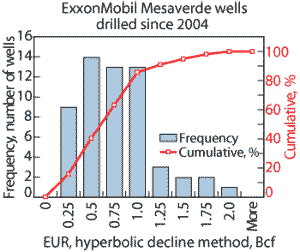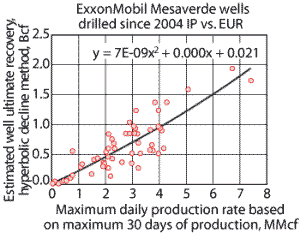What's new in exploration
Winner’s curse: The end of exploration for ExxonMobil? ExxonMobil may have had its worst year ever for reserve replacement in 2007. The company now appears to be following a strategy that favors exploitation and unconventional resource opportunities over conventional international exploration. In a January 2008 review, ExxonMobil Exploration President Tim Cejka told Goldman Sachs that his company’s emphasis would be on exploitation of tight gas reservoirs, capturing opportunities in the LNG value chain and relying more on heavy oil resources. Kurt Rudolf, ExxonMobil chief geoscientist, provided some insight into his company’s perspective on the future of exploration at a recent presentation to the Houston Geological Society.* The title of his talk, “Current exploration trends: Prudent investments or irrational exuberance,” communicates the company’s message: Despite high oil prices, exploration is irrational in today’s highly competitive and restricted business environment. Rudolf described the unacceptable cost of international opportunity capture because of increased competition, tougher production-sharing terms by host governments, and the rising cost of products and services. Remaining opportunities in the international arena are relatively small, because most available blocks are in their second or third phase of appraisal; there is just not much left that is attractive. Rudolf calls this the “winner’s curse,” because if you win a bid round in today’s environment, you lose because the reward doesn’t justify the cost. What happens if you don’t play? The answer for ExxonMobil is to emphasize increased recovery from assets that it already owns in areas with more favorable fiscal terms. Rudolf explained that a rebirth of regional studies and basin modeling has taken place in his company. New concepts, datasets and technologies have led to a renewed emphasis on near-field potential, where risks and costs are lower and financial returns are more immediate. ExxonMobil will focus on efficiency, technology and experience to exploit producing areas, mostly in North America. I appreciate the appeal of exploitation projects over international exploration, though I question whether near-field potential can sustain a giant oil company’s need to replace reserves for very long. In this context, I was astonished to find that a Piceance Basin tight gas-field development project was showcased as one of ExxonMobil’s core assets in its “Opportunity Portfolio” recently presented to analysts.** The company has developed what it calls a “breakthrough-technology” that could improve tight gas well performance by several orders of magnitude. By using Multi-Zone Stimulation Technology (MZST) and annular coiled tubing completion methods, multiple gas zones can be quickly fractured and brought on production. This might allow the company to reach total daily production of 1 Bcfg at its Piceance Creek-Love Ranch (PCLR) asset just 500 days after initiation of development drilling. Rudolf commented more than once in his presentation that, while effective, this completion technology is “really expensive.” In an earlier presentation to Lehman Brothers in September 2007, Senior Vice President Mark Albers stated that ExxonMobil’s Piceance Basin asset was a 35-Tcf resource. It is unclear how much of its acreage position is included in this resource estimate outside of PCLR. It is also true that other companies including EnCana and Williams have made similar claims to huge resources from Mesaverde continuous reservoirs in the Piceance Basin. It is difficult to reconcile these assertions with a US Geological Survey assessment released in 2003 (DDS-69-B) that assigned a mean 3.42 Tcf of undiscovered resources for the entire Piceance Basin in combined continuous and transitional Mesaverde accumulations. The US Department of Energy assigns about 1.0 Tcf of proved reserves to the Piceance Creek field complex, and only 8.2 Tcf to the entire Piceance-Uinta basin region. But the larger problem with ExxonMobil’s tight gas project is that it does not yet appear to be commercially viable. I evaluated 57 wells that were drilled from 2004 to 2007 in the Piceance Creek and Love Ranch Fields that appear to have been completed using the new multi-zone stimulation technology. These wells were evaluated to determine commercial gas reserves using standard rate-vs.-time decline methods. Production histories are relatively short, and monthly rates are sometimes erratic, so individual wells were declined both exponentially and hyperbolically. Hyperbolic declines averaged 15% higher production than the most optimistic exponential projections, so these were used for the evaluation. Based on this analysis, Estimated Ultimate Recovery (EUR) will be less than 1.0 Bcfg for 86% of wells, and less than 1.5 Bcf for 95% of wells. No wells will reach 2.0 Bcfg, Fig. 1.
A company with considerable Piceance Basin operations told me that its commercial, cumulative production threshold is 1 Bcfg for a well that costs $1.25 million and is drilled and fracture-stimulated at an average reservoir depth of 6,500 ft. The average TD for ExxonMobil’s wells is 12,760 ft (9,100-14,800 ft). At nearly twice the depth and using a more expensive fracture treatment and completion method, ExxonMobil’s PCLR wells would have to produce considerably more than 1.0-1.5 Bcf to be profitable. The reserves calculated for the Piceance Creek-Love Ranch Field are consistent with those from a detailed IHS evaluation of the nearby Mamm Creek-Rulison Complex (MCRC). The IHS study includes over 4,000 wells with much longer well production histories than PCLR, but that are at comparable reservoir depths. The major difference between the two field areas is that ExxonMobil’s MZST yields average initial production rates of about 3.0 MMcfd vs. about 0.9 MMcfd for MCRC. This supports ExxonMobil’s claim that MZST minimizes the time from drilling to peak production. The gain appears to be largely through rate acceleration, because average commercial well lives are just over four years at PCLR vs. more than seven years for MCRC to produce similar reserve volumes. How should we interpret these observations? First, let me state a few qualifiers. Obviously, although presented as a core asset, the company’s Piceance Basin assets are only a tiny fraction of the company’s overall asset base. Second, my request to interview Kurt Rudolf and discuss the topics in this column was not granted, so I cannot offer ExxonMobil’s side of the story, outside the public presentations cited previously. Third, my reserve conclusions are based on limited production histories from a relatively small number of wells. Nevertheless, the data are fairly consistent, reserve levels are corroborated by the IHS study at Mamm Creek-Rulison, and correlation at Piceance Creek-Love Ranch between initial production and projected ultimate recovery is quite good, Fig. 2.
ExxonMobil’s project in the Piceance Basin appears marginally commercial at best. It may be that they are in the early phase of a longer-term research and development effort, and that economic results are not yet expected. Perhaps the company is betting on escalating natural gas prices. It seems that ExxonMobil has made a strategic decision to focus on existing assets rather than compete for new opportunities in a highly competitive and over-valued global environment. If the company can unlock the considerable resources of tight gas reservoirs and heavy oil sands, there may be a longer future than it sees through conventional exploration. ExxonMobil hopes to use its strong R&D expertise to optimize production at lower risk and reduced cost. At Piceance Creek-Love Ranch, however, there is little support to date for these outcomes. In the Piceance Basin, ExxonMobil won the thickest part of the gas-saturated Mesaverde reservoir in the deepest part of the basin. It seems that the winner’s curse may apply not only in international bid rounds but also in some captured onshore exploitation opportunities. IHS provided information about the Piceance Basin petroleum system as well as current production data and scouting information. They generously shared preliminary findings from their Mamm Creek-Rulison study. IHS’s ongoing support of this column is greatly appreciated. * Rudolf’s talk was previously presented as the Michel T. Halbouty Lecture at the AAPG Annual Meeting in Long Beach, California, April 2007. ** Cejka, T., ExxonMobil Opportunity Portfolio, January 16, 2008: Goldman Sachs Global Energy Conference, Las Vegas, NV, January 16, 2008, http://ir.exxonmobil.com/phoenix.zhtml?c=115024&p=irol-EventDetails&EventId=1739020.
|
||||||||||||||
- Prices and governmental policies combine to stymie Canadian upstream growth (February 2024)
- U.S. producing gas wells increase despite low prices (February 2024)
- U.S. drilling: More of the same expected (February 2024)
- U.S. oil and natural gas production hits record highs (February 2024)
- Quantum computing and subsurface prediction (January 2024)
- U.S. upstream muddles along, with an eye toward 2024 (September 2023)
- Applying ultra-deep LWD resistivity technology successfully in a SAGD operation (May 2019)
- Adoption of wireless intelligent completions advances (May 2019)
- Majors double down as takeaway crunch eases (April 2019)
- What’s new in well logging and formation evaluation (April 2019)
- Qualification of a 20,000-psi subsea BOP: A collaborative approach (February 2019)
- ConocoPhillips’ Greg Leveille sees rapid trajectory of technical advancement continuing (February 2019)






